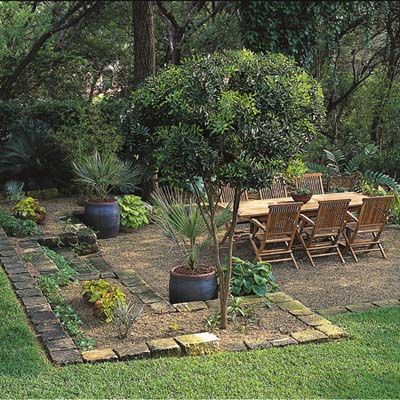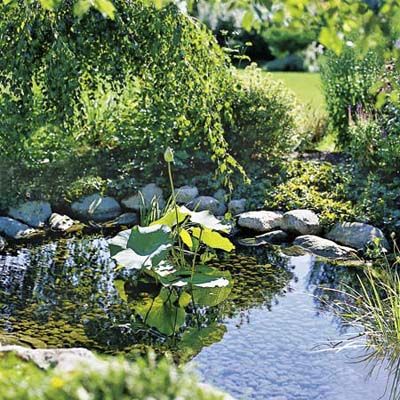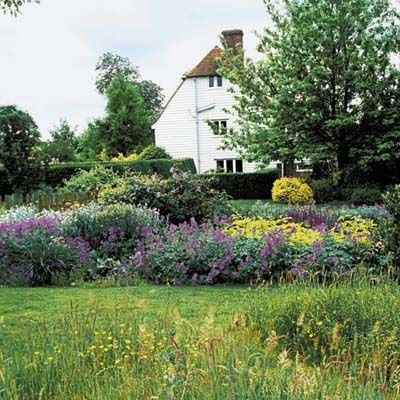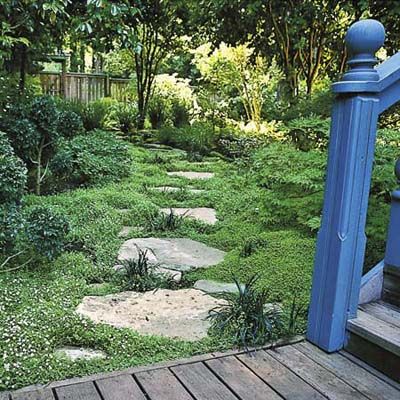Traditional grass lawns have long been a staple of American homes, but some homeowners are seeking alternatives that require less maintenance, conserve water, and create more diverse, eco-friendly landscapes. Lawn-less yards offer a range of benefits and design possibilities that can transform your outdoors into a beautiful and functional space, from lush ground covers to hardscaped patios. This guide will explore various grass-less options, design ideas, and practical tips to help you reimagine your landscape.
What Are the Benefits of Lawn-Less Yards?
Getting rid of grass in your yard can benefit both you and the environment. By transitioning to alternatives to grass lawns, you can significantly decrease the time and resources required for maintenance. This often results in lower water consumption, reduced use of chemical fertilizers and pesticides, and decreased energy expenditure from mowing and other lawn care activities. Lawn-less yards also provide more diverse habitats for local wildlife, improve soil health, and contribute to better stormwater management.

What Are Popular Alternatives To Traditional Grass Lawns
There are various lawn-less design options that suit different styles, climate conditions, and functional needs. Here are some popular alternatives to traditional grass lawns.
Ground Cover Plants
Low-growing ground cover plants can provide a lush, green appearance similar to grass while offering unique textures and, in some cases, colorful blooms. Ground cover plants typically require less water and maintenance than traditional lawns. Popular options include creeping thyme, which tolerates foot traffic and releases a pleasant aroma when stepped on, and blue sedge (Carex glauca), which offers a grasslike appearance with less upkeep.
Mosses
Mosses thrive in shady and moist environments, making them ideal for areas where grass struggles to grow. Common types of moss used for lawns include Bryum (cushion moss), Hypnum (sheet moss), and Thuidium (fern moss). These mosses are known for their ability to form dense, attractive ground cover and their adaptability to different soil and light conditions. Moss lawns contribute to biodiversity by providing a habitat for microorganisms and small wildlife. They also help control soil erosion and improve air quality by absorbing pollutants.
Hardscaping Elements
Incorporating hardscaping elements such as patios, decks, and gravel areas can create functional outdoor living spaces while reducing the need for grass. For example, a dry-laid brick patio or a patch of gravel with outdoor furniture can transform a portion of your yard into an inviting seating area. Opt for permeable options that allow water to percolate through to maintain drainage and soil health.
Native Plant Gardens
Replacing lawn areas with gardens featuring native plants can create a beautiful, low-maintenance landscape that supports local ecosystems. Native plants are adapted to your region’s climate and soil conditions and often require less water and care than non-native species. These gardens can attract beneficial insects, birds, and other wildlife, contributing to a more vibrant and sustainable yard.
Designing a Grassless Front Yard
Creating a grassless front yard can be a bold statement, especially in neighborhoods where manicured lawns are the norm. However, with thoughtful design, you can achieve an attractive and welcoming entrance to your home without relying on grass.
Curving Planting Beds
Establishing deep planting beds that curve along the front and sides of your house allows you to create a lush, garden-like appearance while gradually reducing lawn area. To plan your curved beds, lay out a garden hose in a gentle curve to visualize the shape. Consider how the remaining lawn areas (if any) will be shaped for easy mowing and maintenance.
Permeable Paving Options
Incorporating permeable paving in your front yard design can add visual interest while maintaining good drainage. Options like flagstone pavers with creeping thyme or other low-growing plants between them can create an attractive, rock-garden feel. These permeable surfaces allow water to seep into the soil rather than running off, which is good for the environment and can help prevent water pooling issues.
How Can You Transform Your Backyard Without Grass?
The backyard offers even more opportunities for creative, grass-free designs that can enhance your outdoor living experience and reduce maintenance needs.
Creating Outdoor Living Spaces
Transform a well-defined area close to your house by replacing turf grass with a functional outdoor living space. This could be a patio, deck, or gravel area furnished with comfortable seating, dining sets, or even building an outdoor kitchen. Define these spaces with low walls, perimeter planting beds, or container gardens to create a seamless transition from your home to the outdoor area.
Installing Water Features
Water features can serve as beautiful focal points in a lawn-less backyard while providing soothing sounds and attracting wildlife. Consider adding a small pond, fountain, or birdbath as part of your design. These elements enhance the aesthetic appeal of your yard and create habitats for creatures, adding life and movement to your outdoor space.
Child-Friendly Yard Ideas Beyond Grass

Contrary to popular belief, a yard without grass can still be an exciting and enriching space for children to play and explore.
Natural Play Areas
Create areas that encourage children to connect with nature and engage in imaginative play. A small flower or vegetable garden can provide hands-on learning experiences about plant life and food production. For older children, consider installing a backyard pond that supports fish, frogs, or other wetland creatures.
Educational Garden Spaces
Designate areas in your yard for educational gardens that can spark children’s curiosity about the natural world. You could create the ultimate butterfly garden with plants that attract these colorful insects, a sensory garden with plants of various textures and scents, or a small fruit orchard. These spaces provide play value and teach children about ecology, biology, and environmental stewardship.
How Can You Attract Wildlife to Your Lawn-Less Yard?

A lawn-less yard can be a haven for local wildlife, enhancing biodiversity and bringing nature closer to home.
Bird-Friendly Shrubs and Trees
Incorporate shrubs and trees that provide food and shelter for birds. Good options include highbush blueberry (Vaccinium corymbosum), red osier dogwood (Cornus stolonifera), and various viburnum species. Position these plants near windows to create natural “bird-watching stations” where you can observe wildlife from inside your home.
Butterfly and Bee Gardens
Establish areas dedicated to attracting pollinators like butterflies and bees. Plant native flowers such as goldenrod, sunflowers, and coneflowers, which provide nectar for butterflies and produce seeds for birds in the fall. Creating a “mini meadow” with a mix of native wildflowers supports a diverse range of beneficial insects and creates a beautiful, low-maintenance landscape feature.
Which Ground Cover Options Are Low Maintenance?
Low-maintenance ground covers can be an excellent option for those who still want the look of a lush, green expanse without the upkeep of traditional grass.
Drought-Tolerant Varieties
Choose ground cover plants that can thrive with minimal watering once established. Bearberry (Arctostaphylos uva-ursi) is a good choice for sandy sites, while various juniper species work well in sunny spots. These plants reduce water consumption and require less care than traditional grass lawns.
Foot-Traffic Resistant Choices
If you need ground cover that can withstand some foot traffic, consider options like moss phlox. This plant forms a dense, low-growing mat and is good for hillsides or areas where mowing is difficult. Blue sedge (Carex glauca) is another excellent choice that can tolerate light foot traffic while maintaining a grasslike appearance.
How Can You Incorporate Eco-Friendly Hardscaping?

Incorporating eco-friendly hardscaping elements can enhance the beauty and functionality of your yard, making it a perfect space for relaxation and entertainment without relying on grass.
Recycled Materials
Consider using recycled or repurposed materials for your hardscaping projects. Options such as reclaimed brick, repurposed stone, or recycled glass can add character to your yard while promoting sustainability. These materials often require less energy to produce and can reduce the environmental impact of your landscaping efforts.
Green Walls and Vertical Gardens
Creating vertical gardens or green walls offer an innovative way to incorporate greenery into your landscape without taking up ground space. These structures can be installed on fences, walls, or freestanding frames and planted with a variety of herbs, flowers, or vegetables.
Incorporating Edible Plants
In addition to their aesthetic and environmental benefits, lawn-less yards can be designed to include a variety of edible plants for a productive and sustainable landscape.
Vegetable Beds and Herb Gardens
Incorporate vegetable beds and herb gardens into your landscape design to enjoy fresh, homegrown produce. You can grow vegetables and herbs in raised beds, container gardens, or traditional in-ground planting areas. These spaces can be both functional and visually appealing, especially when combined with ornamental plants and flowers.
Fruit Trees and Berry Bushes
Adding fruit trees and berry bushes to your yard can provide a bountiful harvest of fresh, delicious fruits. Consider planting dwarf or semi-dwarf fruit tree varieties to maximize space and improve manageability. Berry bushes, such as blueberries, raspberries, or blackberries, can be incorporated into shrub borders or dedicated berry patches. These plants produce edible fruits and contribute to the overall beauty and diversity of your landscape.
Maximizing Small Spaces
Even if you have a small yard or limited outdoor space, there are plenty of lawn-less solutions that can help you create an attractive and functional landscape.
Container Gardening
Container gardening allows you to grow a variety of plants in pots, planters, or other containers. This approach is especially useful for small spaces, as it provides flexibility and the ability to move plants as needed. Choose containers of different sizes and shapes to add visual interest and create a dynamic, layered look.
Vertical and Tiered Structures
Vertical and tiered structures can help you maximize your available space and add depth to your landscape. Install trellises, arbors, or pergolas to support climbing plants, or create tiered planting beds to make the most of a small area.
Overcoming Challenges in Lawn Reduction
While transitioning to a lawn-less yard offers many benefits, challenges may arise during the process.
Addressing HOA and Local Regulations
Before making significant changes to your yard, check with your homeowners association (HOA) and local municipality regarding any regulations or restrictions on landscaping. Some areas may have rules about lawn height or the percentage of nongrass areas allowed. Work within these guidelines or consider advocating for changes if the rules are outdated or environmentally unsound.
Managing Water Runoff
As you replace grass with other landscaping elements, be mindful of how these changes might affect water runoff on your property. Incorporate features like rain gardens, bioswales, or permeable paving to manage stormwater. These solutions can help prevent erosion, reduce flooding, and contribute to healthier local waterways.
Step-by-Step Guide To Converting Your Lawn
Transitioning to a lawn-less yard requires careful planning and execution. Follow these steps to ensure a successful project.
Planning and Design
Start by assessing your yard’s current conditions, including sun exposure, soil type, and drainage patterns. Develop a comprehensive design that incorporates your desired features, such as planting beds, hardscaping elements, and functional spaces. Consider consulting with a landscape designer for expert advice on creating a cohesive and sustainable lawn-less yard.
Site Preparation
Properly prepare your site by removing existing grass and weeds. This may involve methods such as solarization, sheet mulching, or mechanical removal. Improve soil quality as needed by adding organic matter or adjusting pH levels. If you’re planning to build self-watering vegetable garden beds, now is the time to prepare those areas.
Installation and Maintenance
Install your chosen landscaping elements according to your design plan. This may include planting ground covers, installing hardscaping features, or creating garden beds. Establish a maintenance routine that works for your new landscape, which may include occasional pruning, mulching, or spot-watering new plants until they’re established. Remember to calculate cubic yards of materials like mulch or gravel to ensure you have enough for your project.
Our Conclusion
Embracing a lawn-less yard is an opportunity to create a more sustainable, diverse, and personalized outdoor space. Reducing or eliminating traditional grass lawns can decrease maintenance requirements, conserve water, and support local ecosystems.
Start with small changes and expand your lawn-less areas over time as you learn what works best for your property and lifestyle. With thoughtful planning and design, your lawn-less yard can become a beautiful, low-maintenance oasis.
